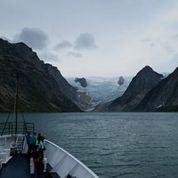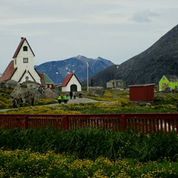WWF is part of a “Students on Ice” expedition from Arctic Canada to Greenland, both sponsoring students, and helping give the students useful skills. WWF staff member Sue Novotny is on board, and is sending blogs about the expedition.
After four days exploring Labrador, southern Greenland seems both familiar and new to the students. The mountains are more jagged, icebergs are far more frequent, and valleys have turned to glaciers. But as we rounded the corner of a fjord, a sight new to almost everyone on board – Greenland’s ice cap, rising almost as high as the enormous mountains.
When Students on Ice visited this site five years ago, the glacier was calving directly into the water. Today, we hiked about a kilometer from shore to the glacier’s edge. The retreat has been so rapid that the area uncovered by ice is still scrubbed free of vegetation.
 Our next stop, “Paradise Valley”, is one of the few places in Greenland where trees can be found. The plants here are now familiar – willow and birch – but far more like shrubs than the tiny plants we saw in Labrador. Paninnguaq (the WWF student from Greenland) was excited to find a much larger piece of birch than she’s seen in her hometown of Sisimiut, above the Arctic Circle. She’s now busy whittling it down to create a traditional Greenlandic toy.
Our next stop, “Paradise Valley”, is one of the few places in Greenland where trees can be found. The plants here are now familiar – willow and birch – but far more like shrubs than the tiny plants we saw in Labrador. Paninnguaq (the WWF student from Greenland) was excited to find a much larger piece of birch than she’s seen in her hometown of Sisimiut, above the Arctic Circle. She’s now busy whittling it down to create a traditional Greenlandic toy.
Finally, we dock in Nanortalik, Greenland’s southernmost town. In Greenlandic, the name means “place of the polar bears”, but there are no bears here today, just a collection of colourful little houses on a rocky landscape.  Culturally, the northern students feel at home here. Despite the occasional language barrier, the students traded performances with the local teenagers, from rap to Inuit games, throat singing and drum dancing, and Greenlandic rock. Tat (the WWF student from Nunavut) has been writing his own rap songs in English and Inuktitut, and performed publicly for the very first time for the Students on Ice. His second performance was to an appreciative crowd in Nanortalik’s youth centre. It’s good to see Inuit youth sharing their culture like this, maintaining ties stretching back thousands of years.
Culturally, the northern students feel at home here. Despite the occasional language barrier, the students traded performances with the local teenagers, from rap to Inuit games, throat singing and drum dancing, and Greenlandic rock. Tat (the WWF student from Nunavut) has been writing his own rap songs in English and Inuktitut, and performed publicly for the very first time for the Students on Ice. His second performance was to an appreciative crowd in Nanortalik’s youth centre. It’s good to see Inuit youth sharing their culture like this, maintaining ties stretching back thousands of years.
